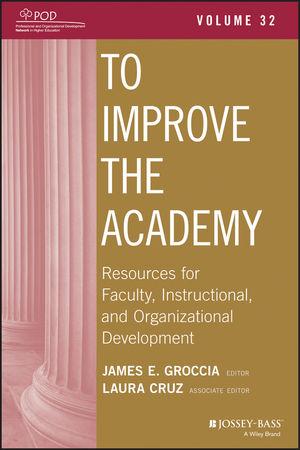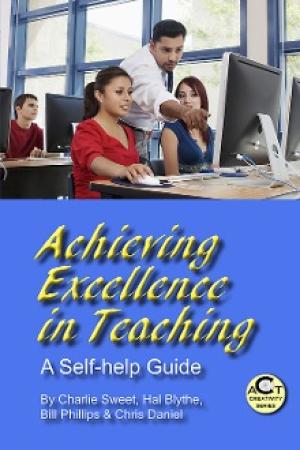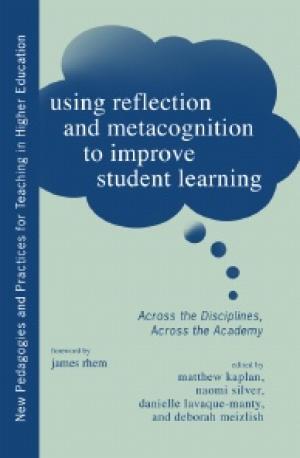Resources by Jane S. Webster

This volume of twenty-one essays comes from the Professional and Organizational Development Network in Higher Education (POD) and is directed to faculty and institutional development staff, department chairs, faculty, deans, student services staff, chief academic officers, and educational consultants. Commensurate with their agenda to facilitate creative exploration, the essays are organized after they are collected, and arranged loosely by topic with about three essays per topic. The topics include developing new paradigms for faculty and professional development, tailoring faculty development to diverse audiences and partners, refining faculty development programs for maximum impact, reflecting on and advancing what developers do, responding to different graduate teaching assistants’ needs, enhancing student learning, and advancing new pedagogical concepts. The essays are written by educators and developers throughout the POD network and undergo a double-blind peer review system. As such, they do not deal with classroom teaching and application per se, but with ways to motivate, involve, measure, and prioritize self-reflective and critical development among educators. Several essays are of particular interest because they propose responses to changes emerging in higher education. Drawing on research into video games and their ability to attract and retain learners, for example, an essay by Kevin Yee encourages educators to apply game theory principles to course design (335-348). Even when instructors might not have the technical savvy to generate their own video game, they can apply the principles of successful gaming with low-tech options in their course design. For example, instructors might design learning opportunities that are narratives (such as a case study or an urgent problem that needs to be solved), have calibrated difficulty and rapid feedback response (such as online quizzes that can be taken until they reach 100 percent), employ diversions (such as add-on TED talks), and generate competition. Another essay, by Al Rudnitsky et al., describes a college-wide multiyear professional development effort that addressed the need for instructors to adapt their expertise to changing needs of students (127-143). It examines how instructors at Smith College formed a process-oriented (rather than skill-based approach) faculty learning community that explored recent research on how people learn, applying it both in their classrooms and in their learning community. They applied such principles as these: ultimately learning depends on what learners do, not what teachers do; existing knowledge has a profound effect on learners’ current thinking and learning; effective learners are metacognitive in that they set goals, self-monitor, and self-regulate; and learning is socially situated and mediated; the instructor’s task is to design complex learning environments and motivate students through evaluation. They contend, “understanding and deep learning that allow for better knowledge transfer and preparation for future learning are privileged educational outcomes” (133). The goal of the process, they found, was to build knowledge through discourse, idea improvement, and collective cognitive responsibility (135). In a third essay worth noting, Michael J. Zeig and Roger G. Baldwin describe concrete recommendations to help senior faculty (sixty-plus years, about 33 percent of professors in the U.S.) develop new meaning and purpose in this phase of their academic life. They suggest that senior faculty reflect on the priorities of their career and identify what resources they need, reconsider what success means in late career, seek out co-mentoring opportunities (in which younger faculty members share their expertise with their mentors, especially in technology), and plan their own professional development. Administrators, deans, and chairs need to see senior faculty members as individuals, maintain reasonable expectations, provide relevant development opportunities, and recognize and appreciate achievement (83-86). This volume is a valuable resource, with a rich bounty of essays geared to building, sustaining, evaluating, and promoting faculty development programs.
This volume of twenty-one essays comes from the Professional and Organizational Development Network in Higher Education (POD) and is directed to faculty and institutional development staff, department chairs, faculty, deans, student services staff, chief academic officers, and educational consultants. Commensurate with their agenda to facilitate creative exploration, the essays are organized after they are collected, and arranged loosely by topic with about three essays per topic. The topics include developing new paradigms for faculty and professional development, tailoring faculty development to diverse audiences and partners, refining faculty development programs for maximum impact, reflecting on and advancing what developers do, responding to different graduate teaching assistants’ needs, enhancing student learning, and advancing new pedagogical concepts. The essays are written by educators and developers throughout the POD network and undergo a double-blind peer review system. As such, they do not deal with classroom teaching and application per se, but with ways to motivate, involve, measure, and prioritize self-reflective and critical development among educators. Several essays are of particular interest because they propose responses to changes emerging in higher education. Drawing on research into video games and their ability to attract and retain learners, for example, an essay by Kevin Yee encourages educators to apply game theory principles to course design (335-348). Even when instructors might not have the technical savvy to generate their own video game, they can apply the principles of successful gaming with low-tech options in their course design. For example, instructors might design learning opportunities that are narratives (such as a case study or an urgent problem that needs to be solved), have calibrated difficulty and rapid feedback response (such as online quizzes that can be taken until they reach 100 percent), employ diversions (such as add-on TED talks), and generate competition. Another essay, by Al Rudnitsky et al., describes a college-wide multiyear professional development effort that addressed the need for instructors to adapt their expertise to changing needs of students (127-143). It examines how instructors at Smith College formed a process-oriented (rather than skill-based approach) faculty learning community that explored recent research on how people learn, applying it both in their classrooms and in their learning community. They applied such principles as these: ultimately learning depends on what learners do, not what teachers do; existing knowledge has a profound effect on learners’ current thinking and learning; effective learners are metacognitive in that they set goals, self-monitor, and self-regulate; and learning is socially situated and mediated; the instructor’s task is to design complex learning environments and motivate students through evaluation. They contend, “understanding and deep learning that allow for better knowledge transfer and preparation for future learning are privileged educational outcomes” (133). The goal of the process, they found, was to build knowledge through discourse, idea improvement, and collective cognitive responsibility (135). In a third essay worth noting, Michael J. Zeig and Roger G. Baldwin describe concrete recommendations to help senior faculty (sixty-plus years, about 33 percent of professors in the U.S.) develop new meaning and purpose in this phase of their academic life. They suggest that senior faculty reflect on the priorities of their career and identify what resources they need, reconsider what success means in late career, seek out co-mentoring opportunities (in which younger faculty members share their expertise with their mentors, especially in technology), and plan their own professional development. Administrators, deans, and chairs need to see senior faculty members as individuals, maintain reasonable expectations, provide relevant development opportunities, and recognize and appreciate achievement (83-86). This volume is a valuable resource, with a rich bounty of essays geared to building, sustaining, evaluating, and promoting faculty development programs.

If you are looking for a book on teaching in higher education that does not scare you off with its heft, or frustrate you with its discipline-specific content, or confuse you with so many tips your head spins, then this little book might be just the thing for you! The authors combine their 110 years of faculty development and educational experience to offer their “Ten Top Traits for Terrific Teachers,” targeting the basic dispositions, skills, and strategies that have the greatest impact on deep student learning. Furthermore, they encourage teachers to reflect on their practice with a series of rubrics and action plans: “To improve by increments you must do something” (108). Throughout, they give snapshot summaries of the best research, all in a conversational tone. In an unusual turn, the first half of the book deals, not with mastery of content or course design, but with the internal drivers of the teacher. According to the research, teachers in the classroom have the most impact on students’ success, especially those teachers who exhibit a set of dispositions, or “positive ideologies of self, others, and the very act of teaching” (17-18). More specifically, these teachers demonstrate passion for their subject, professing, and student success; they care deeply, build excellent rapport with students and colleagues, and demand excellence from students and themselves. These dispositions can be learned. The second half of the book addresses the more external markers of excellent teaching. The authors promote solid organization that clearly identifies student learning outcomes and directly links related assessment and learning activities (47). They promote the use of CRISP to create a unity of purpose in individual classes: Contextualize; Review; Iterate; Summarize; and Preview (49-54). They encourage teachers to be “mentors from the middle,” to assume as necessary such roles as facilitator, coach, artist, critical reflector, model, and scholar (61). The authors encourage the use of technology in service of higher-level learning goals, and they recommend the most useful and cost-effective strategies (71-77). They encourage teachers to integrate their teaching, scholarship, and service in order to stimulate student interest and to model scholarly behavior (95). They promote experimentation and welcome creativity into the classroom both by accident and by design. Finally, they invite teachers to consider their teaching environments – everything from the space in which they teach to the psychological space they create for student risk-tolerance (105-109). While not specifically addressing educational strategies in religion and theology, this little volume compacts significant research on teaching and learning into accessible portions – enough to get started but not too much to overwhelm – with support from a concise and pertinent bibliography. And it invites readers to set plans in place for improvement and on-going assessment with its set of rubrics. The book is a useful entry point for both new and seasoned teachers to revitalize and to enhance their teaching practice. It is my choice for use in faculty development initiatives.

This collection of essays has its origins in a three-year research project at the University of Michigan (funded by the Teagle and Spencer foundations), which intends to find ways to improve undergraduate education by developing “targeted, exportable classroom strategies to help bridge the gap between students’ and faculty’s (or novices’ and experts’) understanding of disciplinary writing and thinking” (2). Based on research that recognizes metacognition as “most important to good learning outcomes” (2), this collection explores whether disciplinary metacognitive strategies will assist students “to better connect diverse disciplinary writing tasks and develop more versatile identities as disciplinary writers” (3). To that end, they include essays on the use of metacognition in several different disciplines: biology, engineering, mathematics, psychology, humanities, and composition. They conclude that both “student and faculty engagement with course material and writing tasks is resoundingly improved by the introduction of metacognitive strategies” (3). The basic premise upon which this collection rests is that people can learn how to learn. This generally takes two forms. In the first, students might be asked to “reflect” on their learning, by attending to their discomfort, ambiguity, and uncertainty, and revisiting a learning experience again and again in order to discover new insights and a more sophisticated understanding (6). In the second, students might engage metacognition (thinking about thinking): they establish a plan to learn (for example, make predictions, set aside sufficient time, gather appropriate resources, and decide which approach will be most efficient based on experience), monitor their learning (with self-tests, for example), and evaluate success (their ability to recall the idea a week later). Attention to metacognition facilitates students’ ability to transfer understanding across disciplines. Teachers in religion and theology might be particularly interested in a number of immediately useable teaching strategies. Consider “exam wrappers”: after giving a test, ask students to describe how they prepared for it; collect their responses, and return them as they begin to prepare for the next test. In this way, students can monitor and evaluate their learning and give their “future selves some advice” (24). Or invite students to monitor their thinking by including comments in the margins on their writing assignments; for example, they might say, “I am not sure I understood how these two ideas connect,” or “I think I have this correctly stated but I may have to check my facts” (122). Or consider inviting students to design a fifteen-week project using a template to identify purpose, audience, context, genre, media, and arrangement strategy; this type of assignment encourages students to make deliberate rhetorical choices and to revise both their design and their product iteratively. Or try this: invite students to “repurpose” their content knowledge in alternative formats (written page, presentation, image, video, blogging, and so forth) in order to develop skills as emerging experts in their profession (178). Each essay provides concrete, practical descriptions of how reflection and metacognition can be used in different disciplines, with abundant samples of assignments, templates, surveys, and student examples.